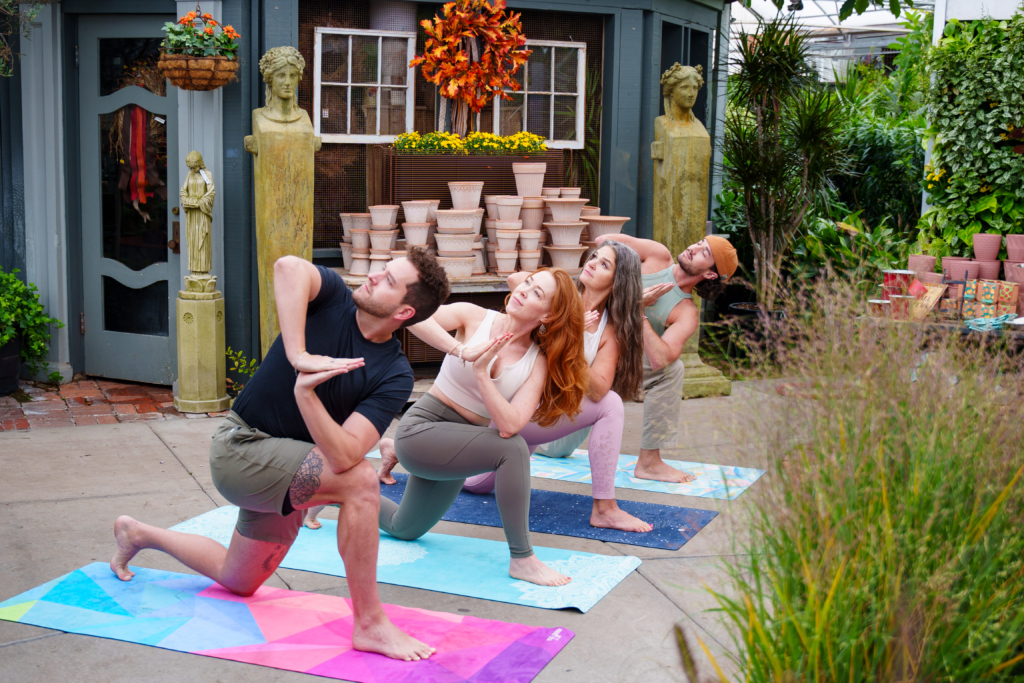This entry was posted on Dec 4, 2024 by Charlotte Bell.

Why is Lunge Pose (Anjaneyasana) such a yoga observe staple? Lunge poses, in all their variations, are core to vinyasa practices and Hatha practices alike. Anjaneyasana lends itself to numerous totally different variations. There are excessive lunges and low lunges, ahead bending and backbending lunges. And there are a number of types of Revolved Lunge Pose (Parvrtta Anjaneyasana). Combining Lunge Pose with spinal rotation is, fairly merely, a profitable mixture.
Lunge Pose is a strong approach to counteract the consequences of recurring sitting. I’ve discovered that Lunge Pose is essentially the most accessible method for my college students to stretch their hip flexors, muscle tissues that may shorten over time if once we sit all day lengthy. As a result of the bend of the again knee is pretty open, folks with range-of-motion points of their knees can observe pain-free lunge poses.
Likewise, sitting and bending over keyboards, counter tops, steering wheels, and so on., may cause our thoracic spines to start to curve ahead over time. Training twisting yoga poses helps maintain our thoracic spines supple. Rotating the backbone is one approach to launch stress within the comfortable tissue across the backbone and improve our common mobility, notably within the higher physique. Twisting stimulates circulation, particularly within the muscle tissues, fascia and organs of the stomach and thorax. Spinal rotation additionally compresses our inner organs to stimulate digestion.
How We Twist
It’s vital to know the place rotation really takes place within the backbone. A in style alignment “rule” instructs you to maintain your hips squared whereas twisting in an effort to create extra of a twist within the lumbar backbone. Sadly, as a result of the side joints within the lumbar backbone forestall that part of the backbone from twisting greater than 1 to 2 levels, the results of this motion, over time, is to trigger the sacroiliac (SI) joint to bear the twist. Rotation of the SI joint can, over time, destabilize the joint and trigger dysfunction, which might trigger plenty of painful situations, comparable to sciatica.
The thoracic backbone, the half linked to the ribcage, is designed for rotation. So whenever you twist, remember the fact that that is the place it’s best to focus your efforts. Relatively than conserving the pelvis squared in twists, permit it to maneuver within the route of your meant rotation, whereas focusing the twist within the thoracic backbone.
Parvrtta Anjaneyasana is a good pose to discover this idea as a result of your hips have numerous room to maneuver.
Find out how to Apply Revolved Lunge Pose
Collect your props: a Yoga Mat and a folded Yoga Blanket (optionally available) for below your knees.
Find out how to Method Revolved Lunge Pose
- There are a number of methods to enter a Lunge Pose. You possibly can strategy it from Tabletop Pose (Bharmanasana) by merely stepping your left foot ahead. You may be bearing weight in your proper knee and left foot.
- You can even begin in Downward Going through Canine Pose (Adho Mukha Svanasana). From Canine Pose, lengthen your left leg up towards the sky, then swing the leg ahead, setting your foot down in between your palms.
- You can even begin from Mountain Pose (Tadasana). Fold ahead into Standing Ahead Bend (Uttanasana). Bend your knees in an effort to place each palms on the ground subsequent to your ft. Step your proper leg again three or so ft, in order that your left shin is vertical. Place your proper knee on the ground.
Add a Twist
- From Lunge Pose, along with your proper knee on the ground and the left foot between your palms, carry your torso to an upright place.
- Rotate your torso towards the left leg. Lengthen your torso as you rotate, permitting your pelvis to rotate together with the torso. Your left hip will likely be greater than your proper hip.
- Preserve your proper leg energetic. Lengthen again by your proper heel.
- Place your proper elbow on the surface of your left thigh. If this causes your respiration to develop into restricted, carry up slightly greater, and place your proper hand on the surface of your left thigh as a substitute.
- In case your elbow is on the surface of your thigh, as within the photograph on the high of this publish, place your palms collectively in entrance of your chest in Anjali Mudra (Prayer Place).
- Breathe and chill out. You might really feel that your torso needs to maneuver out and in of the twist as you exhale and inhale. Loosen up your pose sufficient in an effort to really feel your physique oscillate in rhythm along with your breath.
- Take 5 to 10 deep breaths.
- Unwind, turning the torso again in order that it’s resting over your left leg.
- Return to Tabletop Pose, Downward Going through Canine Pose or Standing Ahead Bend Pose. Loosen up right here for just a few breaths to really feel the consequences of Revolved Lunge Pose.
- Repeat on the opposite aspect.
About Charlotte Bell
Charlotte Bell found yoga in 1982 and started instructing in 1986. Charlotte is the writer of Conscious Yoga, Conscious Life: A Information for On a regular basis Apply and Yoga for Meditators, each printed by Rodmell Press. Her third ebook is titled Hip-Wholesome Asana: The Yoga Practitioner’s Information to Defending the Hips and Avoiding SI Joint Ache (Shambhala Publications). She writes a month-to-month column for CATALYST Journal and serves as editor for Yoga U On-line. Charlotte is a founding board member for GreenTREE Yoga, a non-profit that brings yoga to underserved populations. A lifelong musician, Charlotte performs oboe and English horn within the Salt Lake Symphony and people sextet Pink Rock Rondo, whose DVD gained two Emmy awards.

